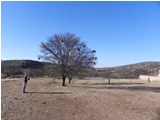Red-billed Quelea breeding in the Worcester area, Western Cape
Introduction
The Red-billed Quelea (hereafter quelea) has not occurred in the Western Cape historically, but in recent decades has started expanding its range into this province. There is a single record of a flock of quelea at Zeekoievlei in 1946. The next record is from the Karoo NP in 1986, and there are records of the quelea every year in the Western Cape since then as it became established in the Beaufort West area. In April and May 2007 there was an influx of quelea on the Cape Peninsula and other areas.Ringing trip
On 6 April 2009 Erna Rabie noticed a flock of quelea of a few hundred, including males in breeding plumage, on her farm Nuwerus. The birds were roosting in reeds on the Nuy river near the bridge on the Worcester Robertson road. On 9 April this was confirmed by Charl Oettle of the Worcester Bird Club. The birds were still present a week later, so I decided to go and ring the quelea if they were still present. On 20-21 April Mike Ford and I set up nets and members of the Worcester Bird Club came to help and observe. By ringing them, there is a small chance of discovering more about their movements in the Western Cape.All quelea captured, were ringed. Samples of Southern Masked Weavers, Cape Weavers and Southern Red Bishops were ringed, as were all other species (2 Cape Bulbul, 3 Levaillants Cisticola and 1 Yellow Canary).
Of the 116 quelea captured, 10 were adult males, 9 were adult females and 97 were recently fledged juveniles. Possibly there had been more adults a few months ago to breed, but most moved on by this stage. Adults were at various stages of primary moult from all old and abraded to active moult to recently completed moult. Males were in full breeding plumage but with head moult started (to moult into non-breeding plumage). Females still had brood patches exposed or new feathers just starting to grow back. Juveniles were identified by their pink bills, usually with dark tips, and new plumage.
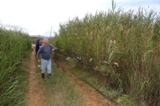
Mike and Erna extracting queleas and weavers from the nets |
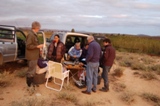
The ringing tables |
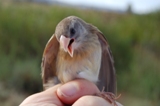
Juvenile Red-billed Quelea |
Breeding
The reeds below the farm dam were searched. Three small areas contained close to a hundred nests each, and there must have been many more areas with nests. Most nests were incomplete, but there were complete nests that had been used for breeding - they had no nest lining but had droppings inside and below the nests (of the chicks) and sometimes egg-shells were found below nests. Two nests had an addled egg each. No active nests were found although this could have been missed.
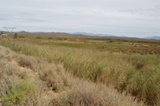
Reeds on Nuwerus farm, where the Red-billed Quelea were roosting and had bred |
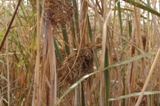
Red-billed Quelea nests in the reeds |
Summary
Breeding may have started in January or February, since some juveniles seemd to be older than some more recently fledged ones. In April breeding had probably been completed, or was very near the end and relatively few adults seemed to remain (visual and ringing records). Quelea were present all day in the reeds, calling and resting, with individuals flying in and out to forage. The population is estimated to be a few hundred.The breeding site is in the Breede River valley and this is home for the juveniles that hatched here, not far from the Overberg wheat growing area.
More web pages about the quelea:
Identification of the Red-billed Quelea
Influx of the Red-billed Quelea
Report sightings of the Red-billed Quelea
Story in Cape Argus: "Feathered locusts arrive in Cape" and Follow-up story "Flying pests are breeding trouble" [the external links are no longer valid]
Report recoveries of rings of these quelea or other birds found with rings
Acknowledgements Thanks to Mike Ford for coming ringing at short notice. Thanks to Hannes and Erna Rabie for their incredible hospitality. Thanks to the members of the Worcester Bird Club for helping with the ringing.








